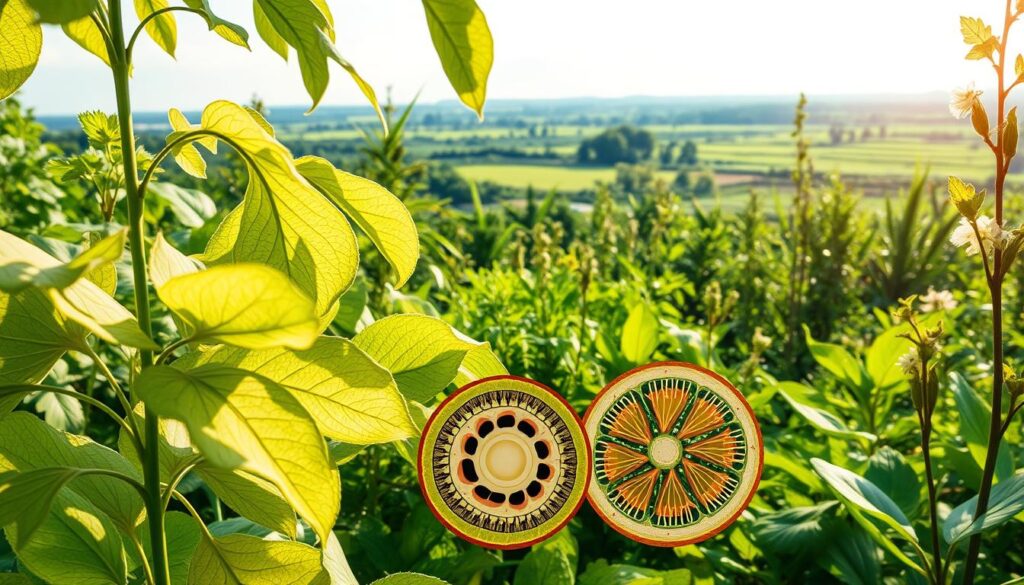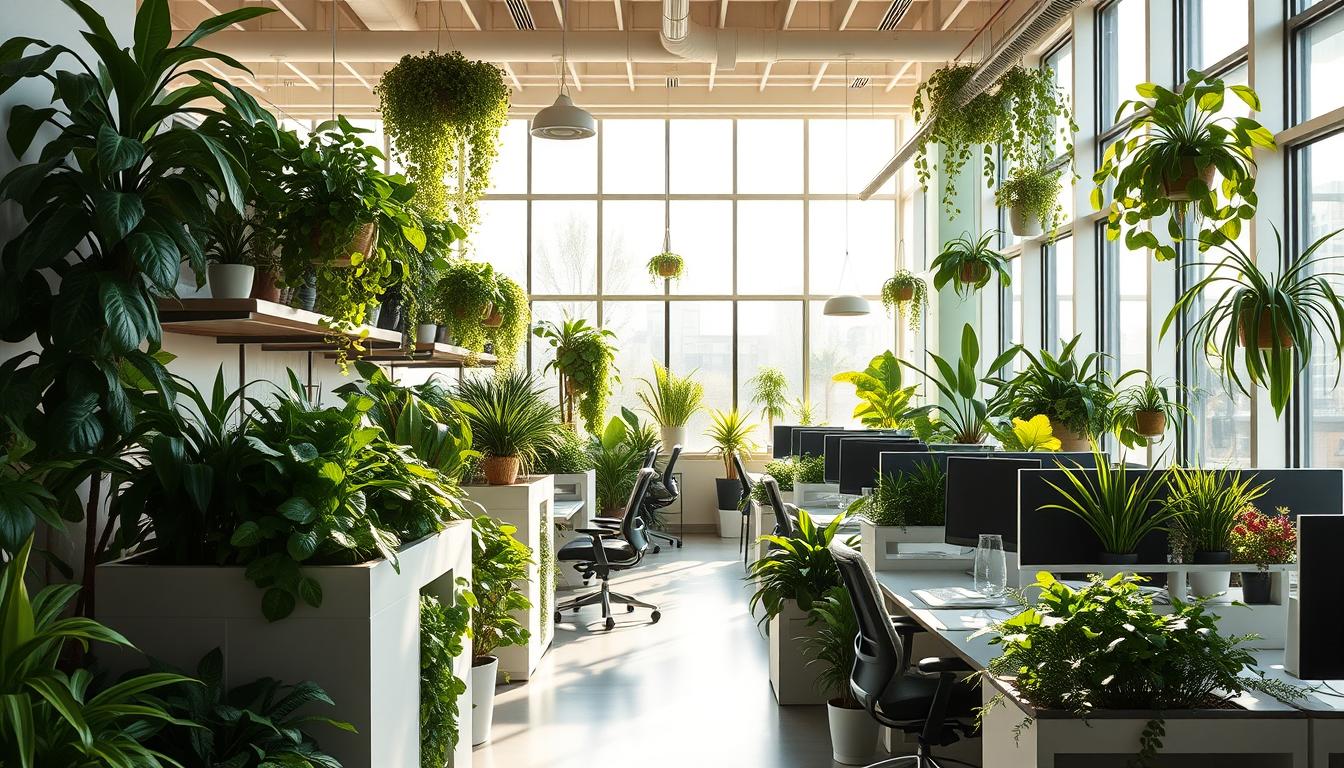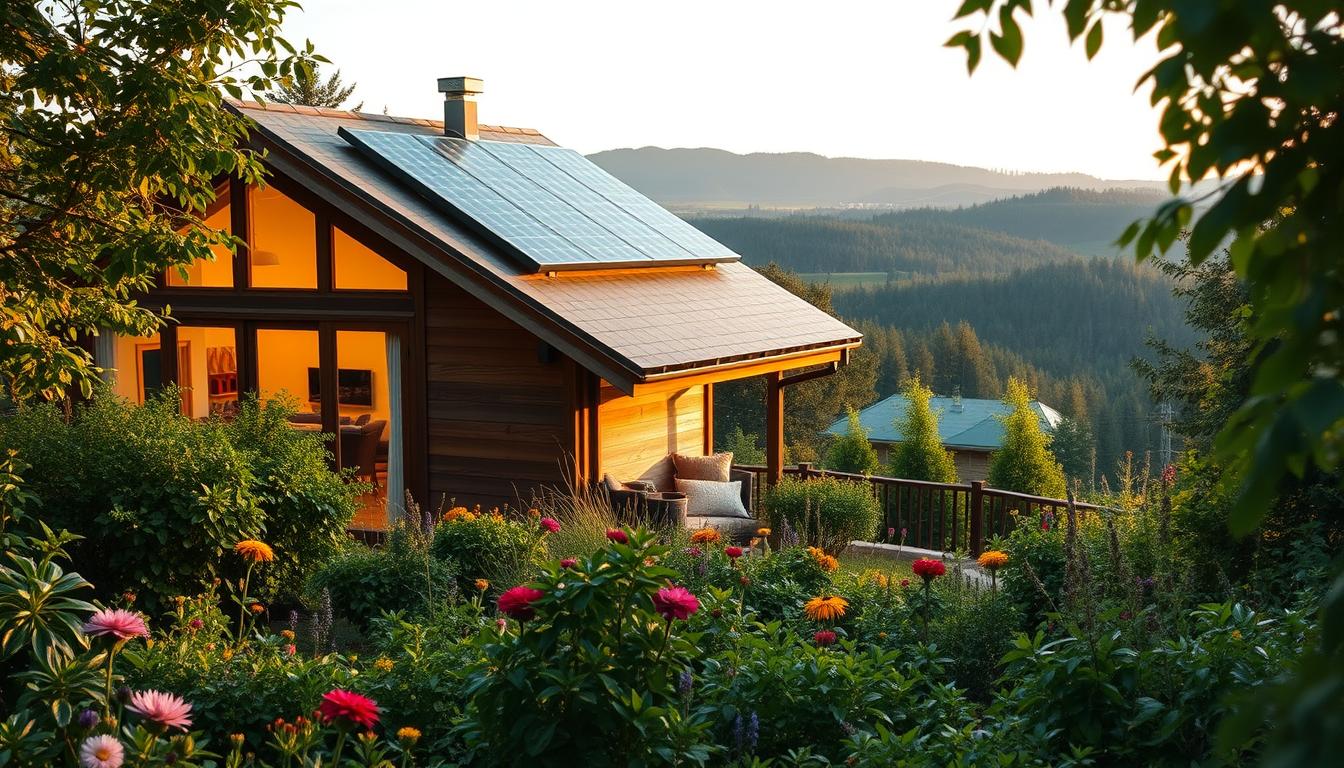Studying how plants cool things down through how close they grow is key for tougher plants. This article looks at how managing how many plants grow together can really help control temperature. This helps with climate control in gardening. Gardeners often struggle with managing their environment.
Learning about how plants are placed and how much leaf cover they have is important. It lets gardeners use eco-friendly methods. This creates healthier ecosystems.
Understanding Thermoregulation in Plants
Thermoregulation in plants is about how they keep their temperature steady. They can’t move, so they use special processes to stay cool or warm. This skill is key to surviving harsh temperatures.
Light, humidity, and soil water are big factors in plant thermoregulation. They affect how plants handle hot or cold changes. Studies show plants change their chemicals fast to deal with heat or cold, helping them with things like making food and fighting stress.

We learn a lot by studying these plant processes. Knowing how plants react to different temperatures helps scientists and farmers. This knowledge helps make plants stronger against the weather.
Importance of Plant Density in Thermoregulation
Plant density is key in controlling temperature and creating microclimates in gardens. Dense plants offer shade, helping to keep the ground cool and moist. This keeps the air humid, which is good for plants. On the other hand, areas with fewer plants can experience harsh temperatures, making plants more likely to dry out and grow poorly.
How close together plants are does more than just affect temperature. It can also make the whole plant community healthier and more productive. The right mix of plants can increase the variety of life in a garden, making it better able to cope with changes in the weather. So, it’s important to plan out how much space each plant needs. This helps control the temperature and keep the garden’s ecosystem stable, allowing plants to flourish.
Physiological Responses to Temperature Changes
Plants react quickly when they face temperature stress. This reaction can start in just minutes to hours. It shows how plants efficiently deal with changes. The creation of heat shock proteins and antioxidants is vital. They play a key role in keeping plants healthy.
Plants use different ways to handle temperature stress. These include tolerance and avoidance methods. Tolerance lets plants withstand tough conditions and keep their metabolism stable. Avoidance methods, meanwhile, protect plants from the harsh effects of extreme temperatures.
Plants’ reactions to temperature stress involve complex processes. These processes are based on the plant’s genetics and evolution. Every plant species has its unique way of dealing with environmental challenges. This is because of differences in their stress response pathways.
Mechanisms of Thermoregulation in Various Plant Species
Different plant species have unique ways to control their temperature. They adapt based on where they live. For example, plants in dry areas have special features to hold onto water. They might have thicker outer layers or roots that reach deep into the ground.
Some plants do well in shady places. They have evolved to survive under trees or in crowded areas. Where a plant comes from affects how it handles temperature. Plants from cold places might not do well in heat. But, plants from warmer places can handle high temperatures better.
Knowing about different plants and how they deal with temperature helps us choose the right ones for an area. This is especially true as the weather changes. Plants that can adjust to different conditions are key for survival in changing environments.
Effects of Plant Density on Microclimates
How you arrange plants in a garden impacts the area’s microclimate. Proper spacing helps manage temperature, moisture, and light. With plants close together, they shade the soil. This keeps moisture from evaporating too quickly, which is key for healthy growth.
But, if plants are too far apart, the sun can hit the soil directly. This might cause it to get too hot and dry out fast. By changing how close plants are, gardeners can control humidity and light. Studies show that smart placement of plants leads to better environments. This helps plants grow stronger and healthier.
Thermoregulation via Plant Density
How you arrange plants is key for controlling temperature in gardens. Smart layout can change air and soil warmth. This makes plants thrive better.
How Plant Arrangement Affects Temperature Regulation
Putting plants close together makes a cool, shaded area. This shield keeps too much heat from harming them. Here are some top gardening tips:
- Strategically clustering plants to maximize shading
- Enhancing airflow to prevent overheating
- Optimizing soil moisture retention through combined root systems
Examining the Role of Foliage Coverage
A lot of leaves help keep temperature steady. This helps plants stay healthy, promotes life variety, and boosts growth. Here’s why good leaf cover matters:
- Reduced evaporative loss of moisture
- Increased protection for soil organisms
- Improved resilience during extreme weather conditions
Adaptations of Plants to Temperature Extremes
Plants have found ways to survive where temperatures change a lot. They have special traits that help them stay strong, even in tough conditions. For example, some have thick coverings or special leaf shapes. These help cut down on heat and keep the moisture in.
Deep roots help some plants reach water deep in the ground. This is especially helpful during dry times. These features help plants and ecosystems keep going, even when temperatures go up and down.
Gardeners and ecologists need to understand these plant adaptations. Knowing which plants can handle big temperature swings helps in choosing the right ones to grow. This ability to adjust is key to keeping ecosystems stable and healthy.
Strategies for Enhancing Plant Thermoregulation
To make gardens better at controlling temperature, we need smart strategies. Picking plants that handle shade well and using companion planting can help. This improves the garden’s temperature and makes it healthier for all plants.
Utilizing Shade-Tolerant vs. Shade-Intolerant Species
Using both types of plants creates a protective layer in the garden. Shade-loving plants keep the ground cool and moist, helping all plants stay healthy. This setup helps keep the garden cooler and supports different kinds of plants.
Employing Companion Planting Techniques
Companion planting makes gardens better at handling heat. It allows plants to support each other, even when stressed. This approach leads to stronger ecosystems that can face tough weather.
Case Studies on Plant Density and Temperature Management
Studies on plant density show big effects on how we manage heat. Many projects have found the right plant layout helps control temperatures in ecosystems. One study showed that certain shading plants keep the microclimate steady, which helps plants stay healthy and strong.
Another important study looked at city gardens. It found that having more plants around could lessen harsh temperatures. These examples share useful tips for gardeners wanting better temperature control in their gardens.
These examples show how different plants and weather factors interact. Biodiversity is key to managing temperatures well. This means having various plants together can help keep temperatures even. Gardeners and those taking care of land can use this info to choose the right amount of plants. This helps keep the area cooler.
The Role of Soil Properties in Plant Thermoregulation
Soil properties are key to how well plants regulate temperature. The texture, nutrients, and moisture in the soil are vital. They not only help plants grow but also let them handle heat and cold better. For example, soils that let air through retain water better. This is important for the roots in extreme temperatures.
Different soils affect what kinds of plants grow and how many there are. This changes the local weather patterns and how plants deal with their surroundings. Knowing about soil’s part in giving plants nutrients helps gardeners and farmers. They can improve the soil to help plants grow strong and regulate temperature well.
As the climate changes, understanding soil’s role in plant temperature control is more crucial. This knowledge helps people garden in a way that’s good for the earth. It lets them use strategies that keep the nutrients flowing. And it makes plants better at adjusting to hot and cold changes.
Future Perspectives on Plant Density and Climate Resilience
Climate change is changing ecosystems rapidly. This makes understanding plant density in building climate resilience very important. Future research will look into new ways to help plants adjust and control their heat. By choosing the right spacing and plants, gardeners and scientists can make plant communities stronger against changing weather.
Studying plant density shows us how to make gardens that support many kinds of life. These gardens can survive tough weather better because of improved heat control. Through focusing on plant density, we can develop ways to make habitats that support life in various climates.
Being proactive in gardening helps build ecosystems that can last. This approach leads to cutting-edge gardening methods. With these methods, gardens not only grow well but also protect against the uncertainty of climate change.
Conclusion
The link between how dense plants are and how they manage heat is key to making gardens more climate-resilient. Understanding this can help gardeners create better conditions for plants to grow healthily. By picking the right plants and gardening smartly, one can keep gardens at the best temperature for plants to face different climate issues.
Research in how plants manage temperature is very important. It helps us figure out how to turn regular gardens into ecosystems full of life. As climate change becomes a bigger issue, knowing about plant density is really important for garden adaptation. Using these tips makes plants and gardens stronger against climate changes.
Gardening combines creativity with scientific knowledge, especially when it comes to plant density and temperature control. By using the latest research, gardeners can find new ways to keep their gardens healthy and productive. This ensures gardens can withstand changing environmental challenges, securing a sustainable future.



